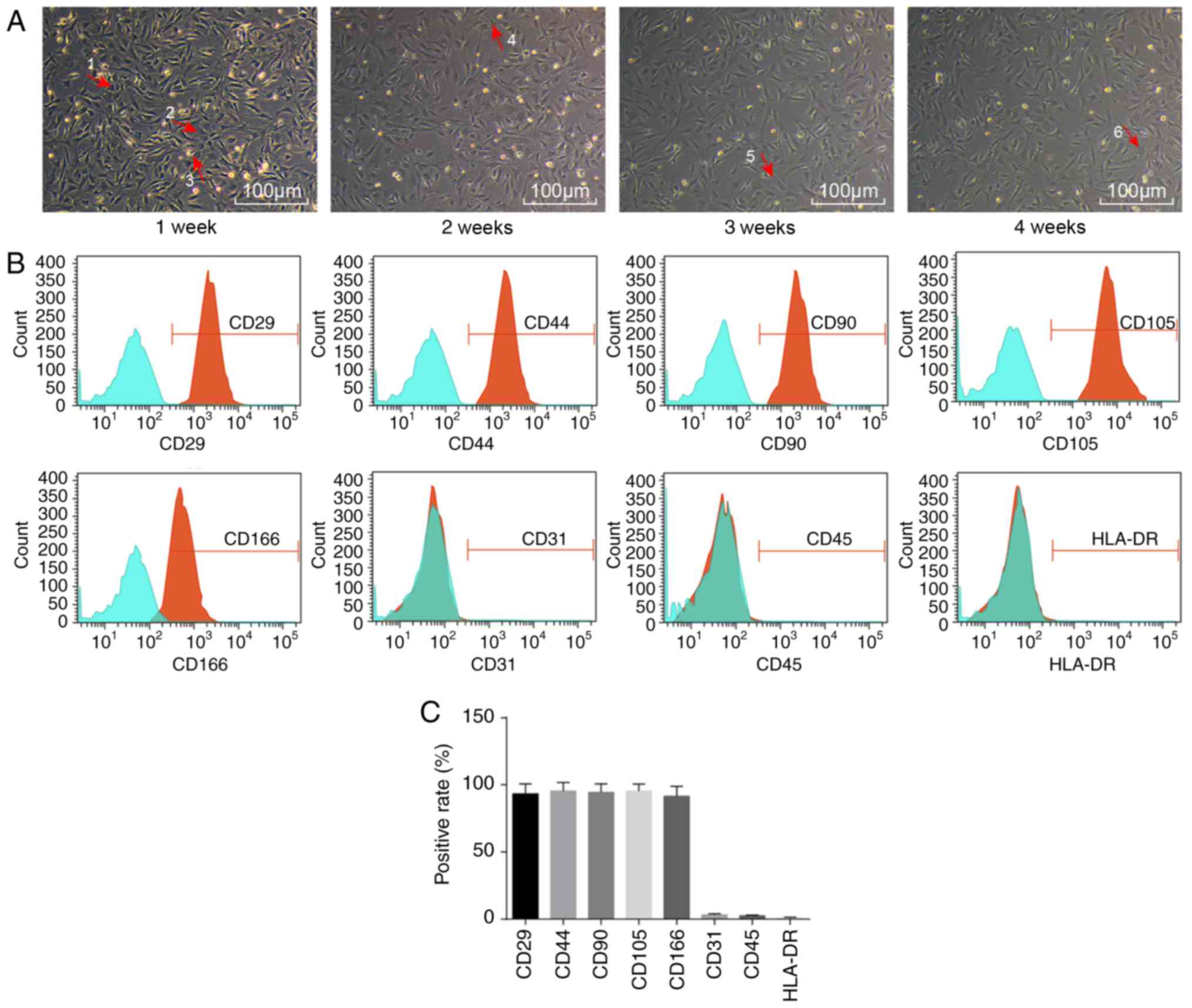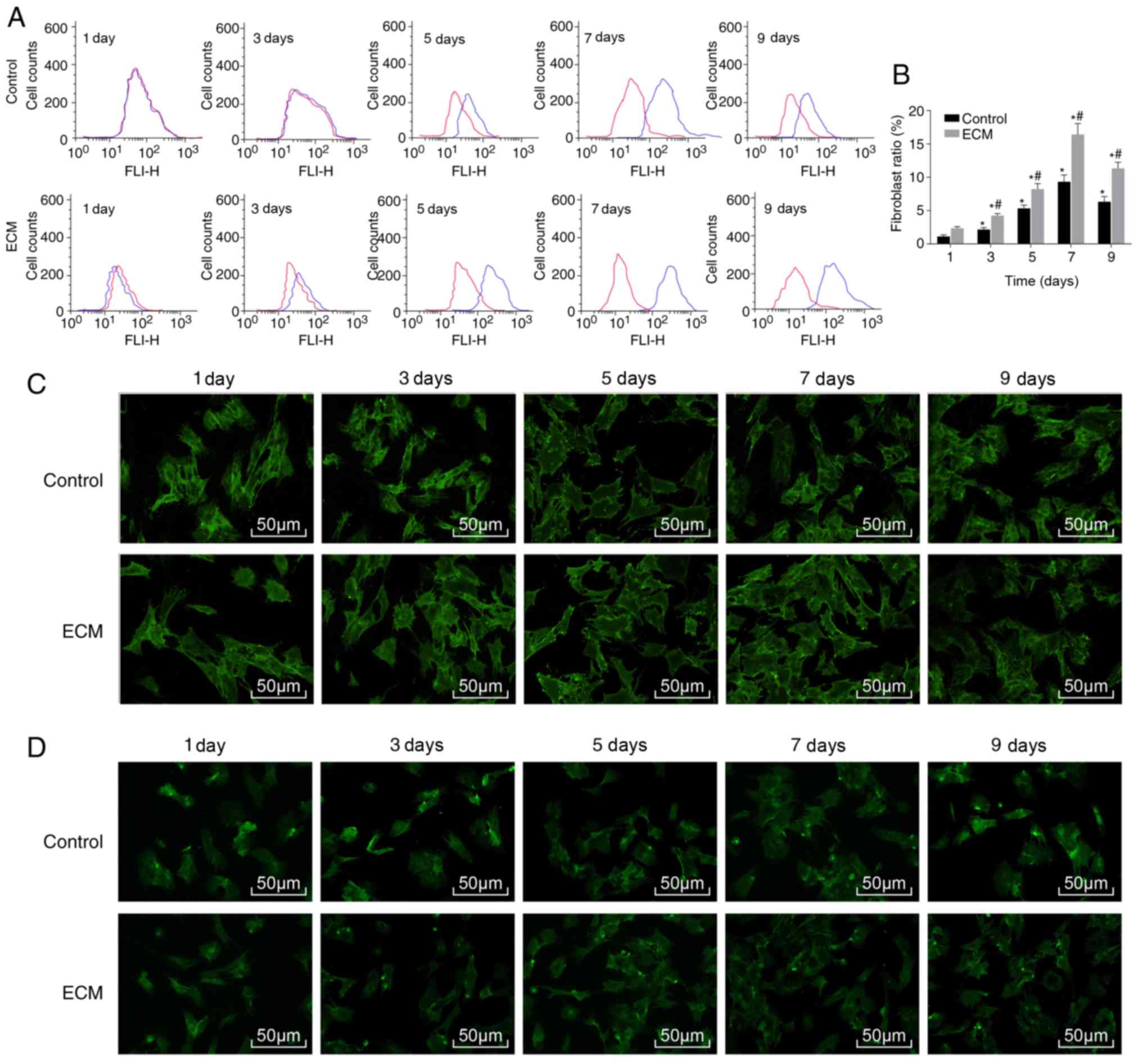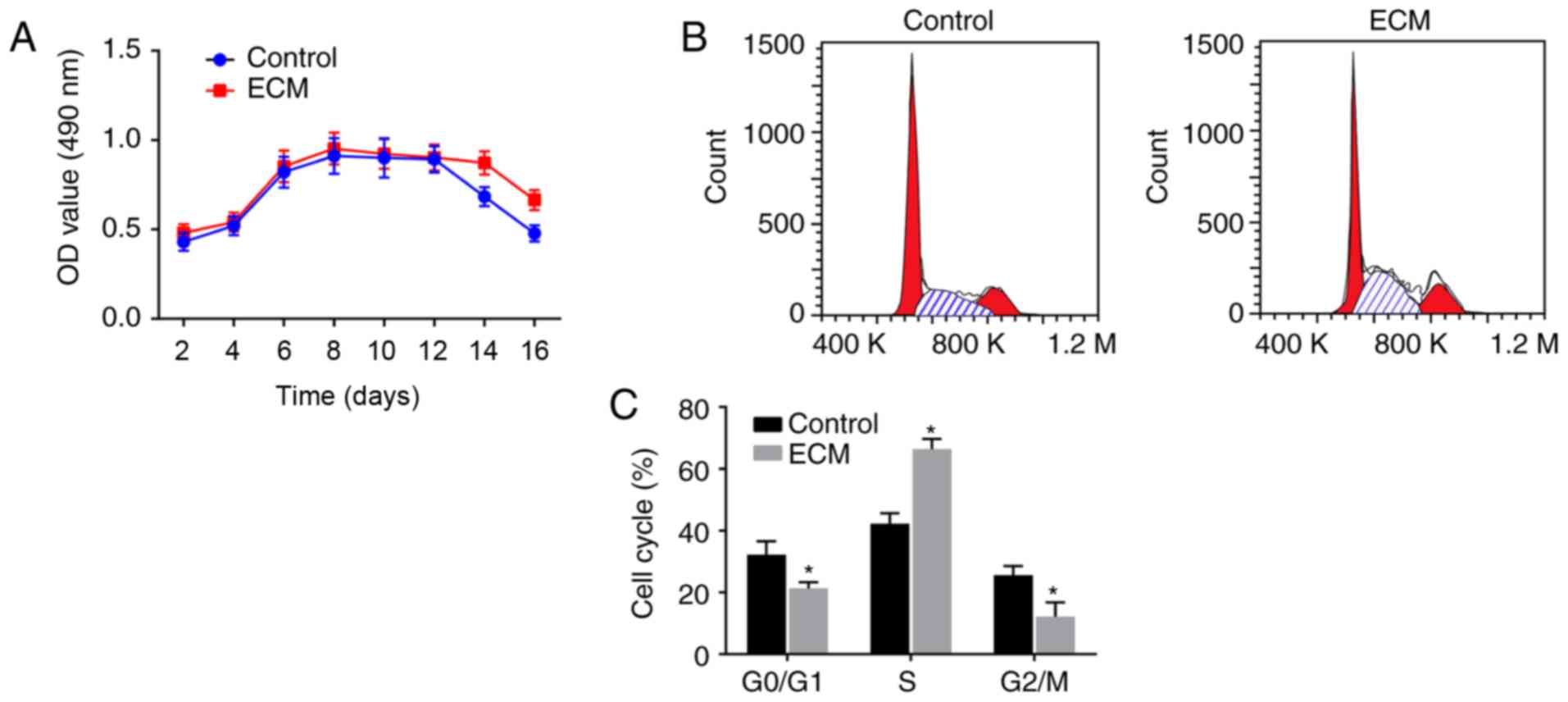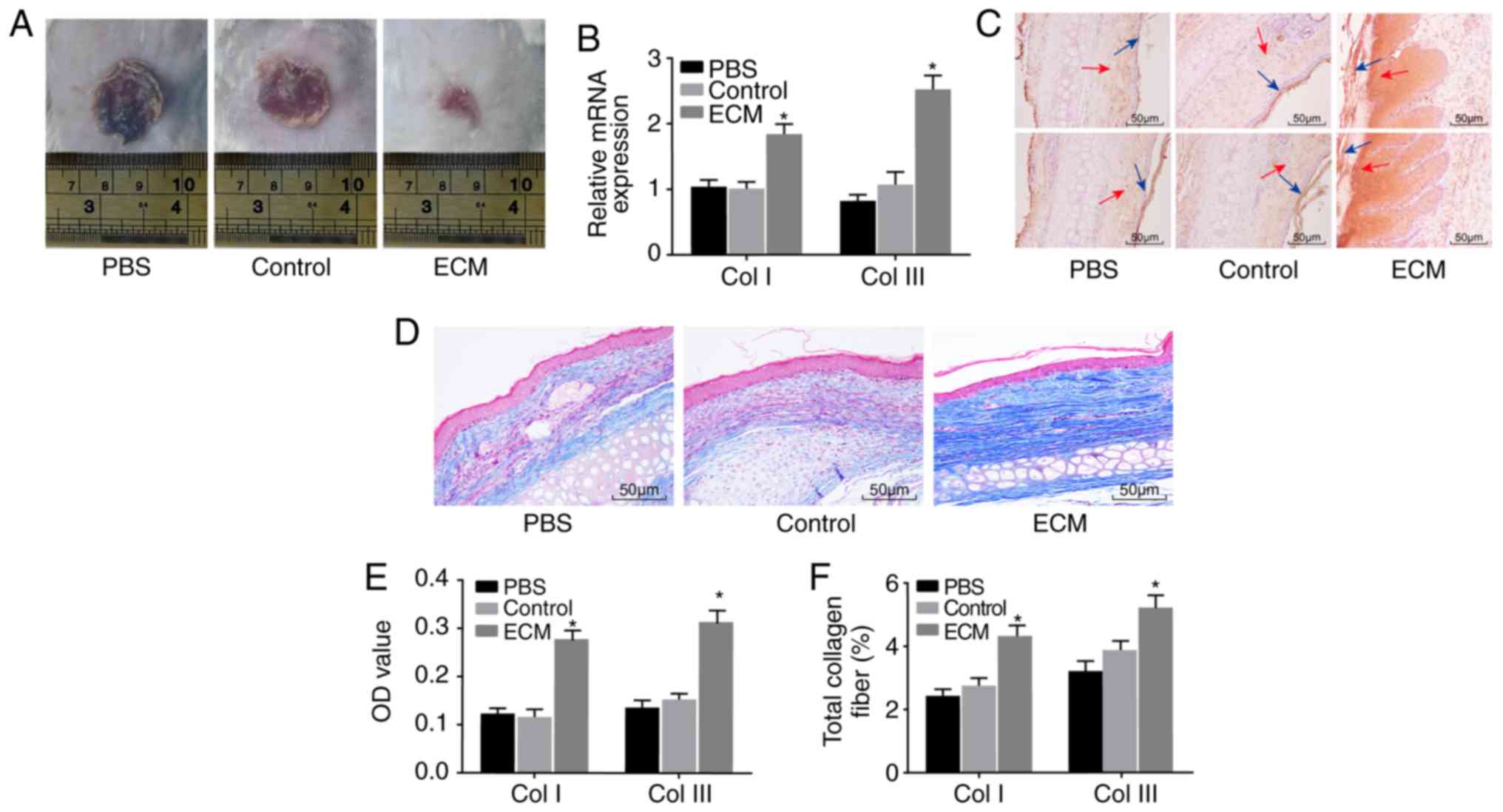|
1
|
Etich J, Bergmeier V, Pitzler L and
Brachvogel B: Identification of a reference gene for the
quantification of mRNA and miRNA expression during skin wound
healing. Connect Tissue Res. 58:196–207. 2017. View Article : Google Scholar
|
|
2
|
Takeo M, Lee W and Ito M: Wound healing
and skin regeneration. Cold Spring Harb Perspect Med.
5:a0232672015. View Article : Google Scholar : PubMed/NCBI
|
|
3
|
Canesso MC, Vieira AT, Castro TB, Schirmer
BG, Cisalpino D, Martins FS, Rachid MA, Nicoli JR, Teixeira MM and
Barcelos LS: Skin wound healing is accelerated and scarless in the
absence of commensal microbiota. J Immunol. 193:5171–5180. 2014.
View Article : Google Scholar : PubMed/NCBI
|
|
4
|
Tanno H, Kawakami K, Ritsu M, Kanno E,
Suzuki A, Kamimatsuno R, Takagi N, Miyasaka T, Ishii K, Imai Y, et
al: Contribution of invariant natural killer T cells to skin wound
healing. Am J Pathol. 185:3248–3257. 2015. View Article : Google Scholar : PubMed/NCBI
|
|
5
|
Jackson WM, Nesti LJ and Tuan RS:
Mesenchymal stem cell therapy for attenuation of scar formation
during wound healing. Stem Cell Res Ther. 3:202012. View Article : Google Scholar : PubMed/NCBI
|
|
6
|
Schmidt BA and Horsley V: Intradermal
adipocytes mediate fibroblast recruitment during skin wound
healing. Development. 140:1517–1527. 2013. View Article : Google Scholar : PubMed/NCBI
|
|
7
|
Goldsmith EC, Bradshaw AD, Zile MR and
Spinale FG: Myocardial fibroblast-matrix interactions and potential
therapeutic targets. J Mol Cell Cardiol. 70:92–99. 2014. View Article : Google Scholar : PubMed/NCBI
|
|
8
|
Sriram G, Bigliardi PL and Bigliardi-Qi M:
Fibroblast heterogeneity and its implications for engineering
organotypic skin models in vitro. Eur J Cell Biol. 94:483–512.
2015. View Article : Google Scholar : PubMed/NCBI
|
|
9
|
Warsinske HC, Ashley SL, Linderman JJ,
Moore BB and Kirschner DE: Identifying mechanisms of homeostatic
signaling in fibroblast differentiation. Bull Math Biol.
77:1556–1582. 2015. View Article : Google Scholar : PubMed/NCBI
|
|
10
|
Driskell RR, Lichtenberger BM, Hoste E,
Kretzschmar K, Simons BD, Charalambous M, Ferron SR, Herault Y,
Pavlovic G, Ferguson-Smith AC and Watt FM: Distinct fibroblast
lineages determine dermal architecture in skin development and
repair. Nature. 504:277–281. 2013. View Article : Google Scholar : PubMed/NCBI
|
|
11
|
Hassan WU, Greiser U and Wang W: Role of
adipose-derived stem cells in wound healing. Wound Repair Regen.
22:313–325. 2014. View Article : Google Scholar : PubMed/NCBI
|
|
12
|
Shingyochi Y, Orbay H and Mizuno H:
Adipose-derived stem cells for wound repair and regeneration.
Expert Opin Biol Ther. 15:1285–1292. 2015. View Article : Google Scholar : PubMed/NCBI
|
|
13
|
Ritter A, Friemel A, Fornoff F, Adjan M,
Solbach C, Yuan J and Louwen F: Characterization of adipose-derived
stem cells from subcutaneous and visceral adipose tissues and their
function in breast cancer cells. Oncotarget. 6:34475–34493. 2015.
View Article : Google Scholar : PubMed/NCBI
|
|
14
|
Hu R, Ling W, Xu W and Han D:
Fibroblast-like cells differentiated from adipose-derived
mesenchymal stem cells for vocal fold wound healing. PLoS One.
9:e926762014. View Article : Google Scholar : PubMed/NCBI
|
|
15
|
Ayuk SM, Abrahamse H and Houreld NN: The
role of photobiomodulation on gene expression of cell adhesion
molecules in diabetic wounded fibroblasts in vitro. J Photochem
Photobiol B. 161:368–374. 2016. View Article : Google Scholar : PubMed/NCBI
|
|
16
|
Goova MT, Li J, Kislinger T, Qu W, Lu Y,
Bucciarelli LG, Nowygrod S, Wolf BM, Caliste X, Yan SF, et al:
Blockade of receptor for advanced glycation end-products restores
effective wound healing in diabetic mice. Am J Pathol. 159:513–525.
2001. View Article : Google Scholar : PubMed/NCBI
|
|
17
|
Galiano RD: Quantitative and reproducible
murine model of excisional wound healing. Wound Repair Regen.
12:485–492. 2004. View Article : Google Scholar : PubMed/NCBI
|
|
18
|
Kusama K, Jiang Y, Toguchi M, Ohno J,
Shikata H, Sakashita H and Sakagami H: Use of the monoclonal
antibody M30 for detecting HSG cell apoptosis. Anticancer Res.
20:151–154. 2000.PubMed/NCBI
|
|
19
|
Liu H, Mu L, Tang J, Shen C, Gao C, Rong
M, Zhang Z, Liu J, Wu X, Yu H and Lai R: A potential wound
healing-promoting peptide from frog skin. Int J Biochem Cell Biol.
49:32–41. 2014. View Article : Google Scholar : PubMed/NCBI
|
|
20
|
Caruana G, Bertozzi N, Boschi E, Pio
Grieco M, Grignaffini E and Raposio E: Role of adipose-derived stem
cells in chronic cutaneous wound healing. Ann Ital Chir. 86:1–4.
2015.PubMed/NCBI
|
|
21
|
Kim WS, Park BS, Sung JH, Yang JM, Park
SB, Kwak SJ and Park JS: Wound healing effect of adipose-derived
stem cells: A critical role of secretory factors on human dermal
fibroblasts. J Dermatol Sci. 48:15–24. 2007. View Article : Google Scholar : PubMed/NCBI
|
|
22
|
Daniunaite K, Serenaite I, Misgirdaite R,
Gordevicius J, Unguryte A, Fleury-Cappellesso S, Bernotiene E and
Jarmalaite S: Epigenetic regulation of human adipose-derived stem
cells differentiation. Mol Cell Biochem. 410:111–120. 2015.
View Article : Google Scholar : PubMed/NCBI
|
|
23
|
Mahmoudifar N and Doran PM: Mesenchymal
stem cells derived from human adipose tissue. Methods Mol Biol.
1340:53–64. 2015. View Article : Google Scholar : PubMed/NCBI
|
|
24
|
Huang SJ, Fu RH, Shyu WC, Liu SP, Jong GP,
Chiu YW, Wu HS, Tsou YA, Cheng CW and Lin SZ: Adipose-derived stem
cells: Isolation, characterization, and differentiation potential.
Cell Transplant. 22:701–709. 2013. View Article : Google Scholar
|
|
25
|
Gao S, Zhao P, Lin C, Sun Y, Wang Y, Zhou
Z, Yang D, Wang X, Xu H, Zhou F, et al: Differentiation of human
adipose-derived stem cells into neuron-like cells which are
compatible with photocurable three-dimensional scaffolds. Tissue
Eng Part A. 20:1271–1284. 2014. View Article : Google Scholar :
|
|
26
|
Rodriguez J, Boucher F, Lequeux C,
Josset-Lamaugarny A, Rouyer O, Ardisson O, Rutschi H,
Sigaudo-Roussel D, Damour O and Mojallal A: Intradermal injection
of human adipose-derived stem cells accelerates skin wound healing
in nude mice. Stem Cell Res Ther. 6:2412015. View Article : Google Scholar : PubMed/NCBI
|
|
27
|
Guneta V, Loh QL and Choong C:
Cell-secreted extracellular matrix formation and differentiation of
adipose-derived stem cells in 3D alginate scaffolds with tunable
properties. J Biomed Mater Res A. 104:1090–1101. 2016. View Article : Google Scholar : PubMed/NCBI
|
|
28
|
Reilly GC and Engler AJ: Intrinsic
extracellular matrix properties regulate stem cell differentiation.
J Biomech. 43:55–62. 2010. View Article : Google Scholar
|
|
29
|
Dzobo K, Turnley T, Wishart A, Rowe A,
Kallmeyer K, van Vollenstee FA, Thomford NE, Dandara C, Chopera D,
Pepper MS and Parker MI: Fibroblast-derived extracellular matrix
induces chondrogenic differentiation in human adipose-derived
mesenchymal stromal/stem cells in vitro. Int J Mol Sci.
17:E12592016. View Article : Google Scholar : PubMed/NCBI
|
|
30
|
Park IS, Chung PS and Ahn JC:
Adipose-derived stromal cell cluster with light therapy enhance
angiogenesis and skin wound healing in mice. Biochem Biophys Res
Commun. 462:171–177. 2015. View Article : Google Scholar : PubMed/NCBI
|
|
31
|
Shokrgozar MA, Fattahi M, Bonakdar S,
Ragerdi Kashani I, Majidi M, Haghighipour N, Bayati V, Sanati H and
Saeedi SN: Healing potential of mesenchymal stem cells cultured on
a collagen-based scaffold for skin regeneration. Iran Biomed J.
16:68–76. 2012.PubMed/NCBI
|
|
32
|
Desai VD, Hsia HC and Schwarzbauer JE:
Reversible modulation of myofibroblast differentiation in
adipose-derived mesenchymal stem cells. PLoS One. 9:e868652014.
View Article : Google Scholar : PubMed/NCBI
|
|
33
|
Grabska-Liberek I, Galus R, Owczarek W,
Wlodarsk K, Zabielski S, Malejczyk J and Sladowski D: Collagen
based dressings in the treatment of wound healing. Pol Merkur
Lekarski. 35:51–54. 2013.In Polish. PubMed/NCBI
|
|
34
|
Jabłońska-Trypuć A, Matejczyk M and
Rosochacki S: Matrix metalloproteinases (MMPs), the main
extracellular matrix (ECM) enzymes in collagen degradation, as a
target for anticancer drugs. J Enzyme Inhib Med Chem. 31:177–183.
2016. View Article : Google Scholar
|
|
35
|
Sivan U, Jayakumar K and Krishnan LK:
Matrix-directed differentiation of human adipose-derived
mesenchymal stem cells to dermal-like fibroblasts that produce
extracellular matrix. J Tissue Eng Regen Med. 10:E546–E558. 2016.
View Article : Google Scholar
|
|
36
|
Rolin GL, Binda D, Tissot M, Viennet C,
Saas P, Muret P and Humbert P: In vitro study of the impact of
mechanical tension on the dermal fibroblast phenotype in the
context of skin wound healing. J Biomech. 47:3555–3561. 2014.
View Article : Google Scholar : PubMed/NCBI
|
|
37
|
Pericacho M, Velasco S, Prieto M, Llano E,
López-Novoa JM and Rodriguez-Barbero A: Endoglin haploinsufficiency
promotes fibroblast accumulation during wound healing through Akt
activation. PLoS One. 8:e546872013. View Article : Google Scholar : PubMed/NCBI
|














